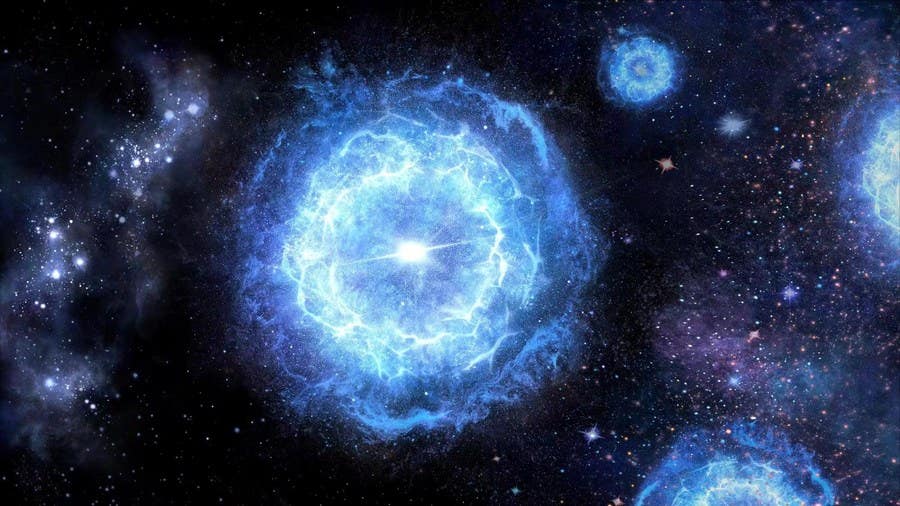Scientists discover traces of the universe’s first stars
An international research collaboration has unearthed the first chemical imprints of the oldest stars to ever twinkle in our cosmos.

[Oct. 15, 2023: Staff Writer, The Brighter Side of News]
This image provided by the National Astronomical Observatories of China (NAOC) shows the first generation stars end up as a special type of supernovae, called pair-instability supernovae (PISN). (CREDIT: NAOC/Handout via Xinhua)
In a historic breakthrough, an international research collaboration has unearthed the first chemical imprints of the oldest stars to ever twinkle in our cosmos. Spearheaded by a group of astrophysicists and scientists from China, Australia, and Japan, the study, recently showcased in the renowned Astrophysical Journal, throws light on the massive stars that once adorned the nascent universe.
The journey to this landmark discovery stretches back decades. “Astronomers had speculated that in the early universe, there were stars that could be extremely colossal,” Zhao Gang, a luminary from the National Astronomical Observatories, Chinese Academy of Sciences, commented on the ongoing quest. “Scientists had been trying to find the proof for decades.” Now, their tireless pursuit has borne fruit.
Zhao Gang's revelation pertains to the pioneering 'first-generation stars'. These cosmic beacons, illuminating the universe merely 100 million years post the Big Bang, potentially boasted a mass a staggering 260 times that of our sun. This new-found data harmoniously aligns with long-standing astronomical forecasts.
An artist’s impression of distant gas clouds. (CREDIT: European Southern Observatory)
In the cosmic ballet, these first-generation stars were ephemeral dancers. Their lifespan was fleeting, culminating in partial explosions. Their legacy, however, is eternal, detectable in the subsequent star generations via the unique chemical autographs they bequeathed. This continuous transfer of chemical signatures forms a celestial lineage linking the very first stars to their cosmic descendants.
The initial stars were composed almost exclusively of hydrogen and helium, in stark contrast to their modern counterparts, which are enriched with metallic elements. Guided by this understanding, the researchers embarked on a quest for stars showcasing minimal metallic characteristics.
Carbon-to-iron ratio as a function of [Fe/H] of all our gaseous absorption systems (filled circles) and of stars in UFDs (light-blue squares), dwarf spheroidal galaxies (blue squares), and the MW (gray/black squares). (CREDIT: Astrophysical Journal)
At the heart of their research was a star christened 'LAMOST J1010+2358'. Distinguished by its specific chemical features, this star unlocked the secrets of the universe's infancy. A comparative analysis between its chemical spectrum and theoretical frameworks led to a momentous conclusion – its progenitor, a first-generation star, possessed a mass 260 times that of our sun.
Alexander Heger, a distinguished professor at Monash University’s School of Physics and Astronomy, elucidated on the monumental implications of this discovery. “The first-generation star we observed has the potential to become the oldest star we have ever seen,” he remarked.
“It probably had only lived for 2 1/2 million years and then exploded.” Emphasizing the import of such studies, Heger stated, “It’s about understanding our origins and the origins of the universe. So far, this is sort of a blind spot in our understanding of the entire history of the universe.”
Related Stories
Such a groundbreaking discovery isn't without its challenges. Quentin Andrew Parker, the esteemed director of the Laboratory for Space Research at the University of Hong Kong, likens the quest to a proverbial needle in a haystack, given the sheer multitude of stars in our galaxy. Notably, Parker was not a direct contributor to the research, yet he championed its significance.
The revelation was empowered by observations from two terrestrial titans: the Large Sky Area Multi-Object Fibre Spectroscopic Telescope (LAMOST) in the vicinity of Beijing, and the Subaru Telescope in Hawaii, under the aegis of the National Astronomical Observatory of Japan.
Parker extolled the capabilities of the LAMOST telescope, highlighting its unparalleled efficiency in obtaining spectra for myriad stars. “You can take 4,000 spectra of 4,000 different objects at the same time,” he expressed with evident admiration.
MDF of our 30 absorbers assuming solar relative abundances (green) and Cayrel's relative abundances (purple) in the photoionization model. A dashed line at [Fe/H] = −1.8 separates the very metal-poor (VMP) absorbers from the others. (CREDIT: Astrophysical Journal)
However, beyond the prowess of technology and science, lies the power of human collaboration. Parker underlined the immense success of this research as not only a milestone in fundamental science but as a testament to "wonderful international collaboration". Harnessing the expertise and insights of a global scientific community, he pointed out, was instrumental. “That’s how modern science works at its best,” Parker affirmed.
Thus, the discovery stands as a monumental testament to both human ingenuity and the awe-inspiring tapestry of the universe, revealing chapters of a story that began at the very dawn of time.
Note: Materials provided above by The Brighter Side of News. Content may be edited for style and length.
Like these kind of feel good stories? Get the Brighter Side of News' newsletter.
Joseph Shavit
Head Science News Writer | Communicating Innovation & Discovery
Based in Los Angeles, Joseph Shavit is an accomplished science journalist, head science news writer and co-founder at The Brighter Side of News, where he translates cutting-edge discoveries into compelling stories for a broad audience. With a strong background spanning science, business, product management, media leadership, and entrepreneurship, Joseph brings a unique perspective to science communication. His expertise allows him to uncover the intersection of technological advancements and market potential, shedding light on how groundbreaking research evolves into transformative products and industries.



